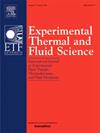Unsteady boundary-layer transition measurements with Temperature-Sensitive Paint under cryogenic conditions
IF 2.8
2区 工程技术
Q2 ENGINEERING, MECHANICAL
Experimental Thermal and Fluid Science
Pub Date : 2025-01-21
DOI:10.1016/j.expthermflusci.2025.111414
引用次数: 0
Abstract
The study presents the first measurement of boundary-layer transition on a harmonically-pitching airfoil under cryogenic conditions. The experiments were conducted in the cryogenic wind tunnel of the German–Dutch Wind Tunnels in Cologne using a test rig especially designed for harmonic pitch oscillations of a two-dimensional model equipped with the laminar NLF(2)-0415 airfoil. The tests were performed at free stream Reynolds and Mach numbers of and . Unsteady pitch oscillations were investigated at different pitch frequencies (up to 40 Hz, i.e. a reduced frequency of 0.540) and pitch amplitudes, as well as for a steady angle-of-attack polar for comparison. The boundary-layer transition movement was captured by means of spatially high-resolving temperature-sensitive paint using a surface-integrated heating layer of carbon nanotubes (cntTSP) and fast-response pressure transducers. The cntTSP data was processed according to the already established “Differential Thermography” (DT) method as well as using a recently presented method based on the evaluation of the qualitative distribution of the heat-transfer coefficient (HTC). The techniques are described in detail and results are evaluated with respect to measurement-based thermal hysteresis as well as the influence of varying pitch frequency and amplitude. The latter could successfully be measured by all applied methods. The findings further reveal significant improvements in the detection of unsteady boundary-layer transition when applying the HTC method compared to DT. These are: a reduction of the measurement error in terms of the thermal hysteresis component in the results and an increased result density at pitch phases, where the DT method inherently fails to yield results.

求助全文
约1分钟内获得全文
求助全文
来源期刊

Experimental Thermal and Fluid Science
工程技术-工程:机械
CiteScore
6.70
自引率
3.10%
发文量
159
审稿时长
34 days
期刊介绍:
Experimental Thermal and Fluid Science provides a forum for research emphasizing experimental work that enhances fundamental understanding of heat transfer, thermodynamics, and fluid mechanics. In addition to the principal areas of research, the journal covers research results in related fields, including combined heat and mass transfer, flows with phase transition, micro- and nano-scale systems, multiphase flow, combustion, radiative transfer, porous media, cryogenics, turbulence, and novel experimental techniques.
 求助内容:
求助内容: 应助结果提醒方式:
应助结果提醒方式:


